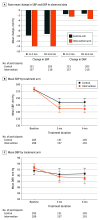Emergency Department-Based Education and mHealth Empowerment Intervention for Hypertension: The TOUCHED Randomized Clinical Trial
- PMID: 40266598
- PMCID: PMC12019670
- DOI: 10.1001/jamacardio.2025.0675
Emergency Department-Based Education and mHealth Empowerment Intervention for Hypertension: The TOUCHED Randomized Clinical Trial
Abstract
Importance: Hypertension is a leading risk factor for cardiovascular diseases and is often undiagnosed. Emergency department (ED) visits serve as critical access points within health care and present a unique opportunity for hypertension screening and intervention.
Objective: To evaluate the effectiveness of an Education and mHealth Empowerment (E2) intervention compared with usual care in reducing systolic blood pressure (SBP) among patients with elevated BP discharged from the ED.
Design, setting, and participants: This randomized clinical trial enrolled participants who presented to an urban academic medical center ED for any indication and had elevated blood pressure (≥140/90 mm Hg and ≤180/110 mm Hg). Eligible participants who were discharged from the ED were enrolled between February 12, 2019, and March 31, 2023, and were randomized to receive either usual care or the intervention with follow-up visits at 3 and 6 months.
Interventions: Usual care involved standard hypertension discharge instructions with a referral for outpatient follow-up. The E2 intervention involved a 3-prong approach, which included a brief Post-Acute Care Hypertension consultation (PACHT-c) with a clinical pharmacist or an advanced practice nurse, a smartphone-enabled BP monitoring kit (Withings device and mobile app) for daily self-monitoring along with behavior change text messages, and primary care referral.
Main outcomes and measures: The primary outcome was the mean change in SBP (mm Hg) from baseline to 6 months.
Results: Of the 574 participants enrolled, mean (SD) age was 51.1 (12.5) years, and 323 (56%) were female; 413 were Black (72%), 115 were Hispanic or Latino (20%), 27 were White (5%), and 19 were other race and ethnicity (3%), which included Asian, American Indian, and other racial or ethnic groups. Of the 413 patients with BP data at 6 months, the E2 intervention group (n = 210) showed a greater mean reduction in SBP (mean difference, 4.9 mm Hg; 95% CI, 0.8-9.0 mm Hg; P = .02) compared with the usual-care group (n = 203). A similar proportion of patients achieved BP less than or equal to 140/90 mm Hg at 6 months in the intervention arm (42.9% [90 of 210]) and the control arm (36.9% [75 of 203]; P = .22).
Conclusions and relevance: In this single-center randomized clinical trial, a multicomponent intervention directed at patients in the ED who have elevated BP was associated with greater reduction in SBP at 6 months. Identifying patients who present to the ED with hypertension may be a viable strategy to improve BP management.
Trial registration: ClinicalTrials.gov Identifier: NCT03749499.
Conflict of interest statement
Figures


References
-
- Million Hearts . Estimated hypertension prevalence, treatment, and control among US adults. Accessed November 1, 2024. https://millionhearts.hhs.gov/data-reports/hypertension-prevalence.html
-
- Cairns C, Kang K. National Hospital Ambulatory Medical Care Survey: 2021 Emergency Department Summary Tables. National Center for Health Statistics; 2023.
Publication types
MeSH terms
Associated data
LinkOut - more resources
Full Text Sources
Medical

